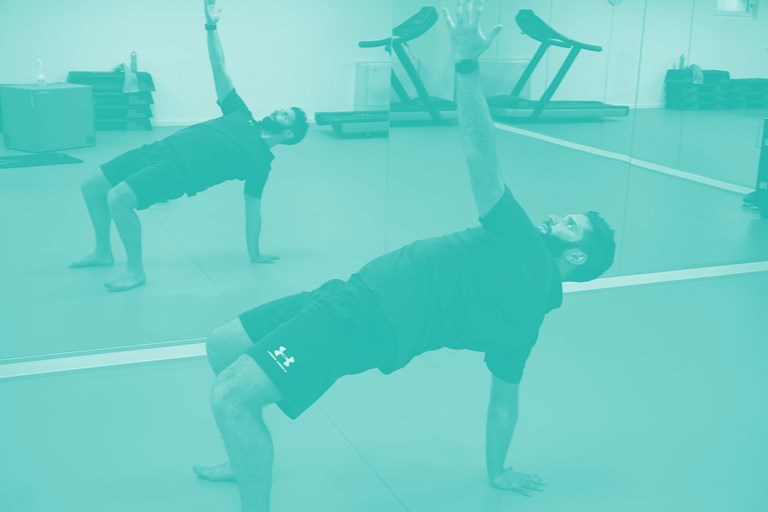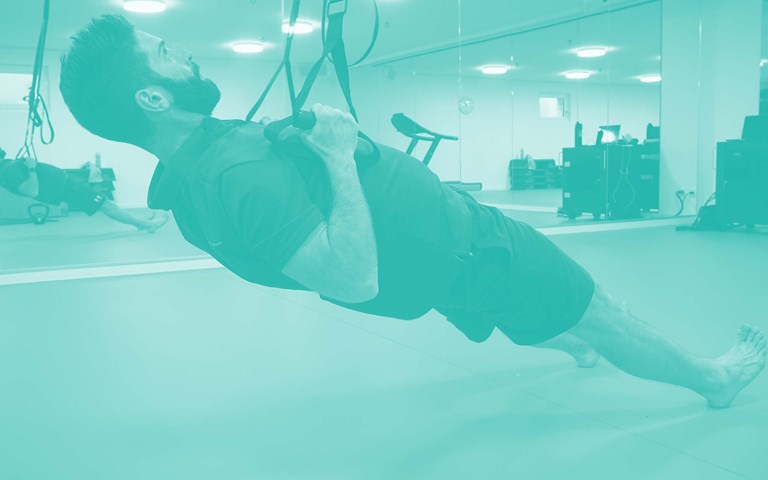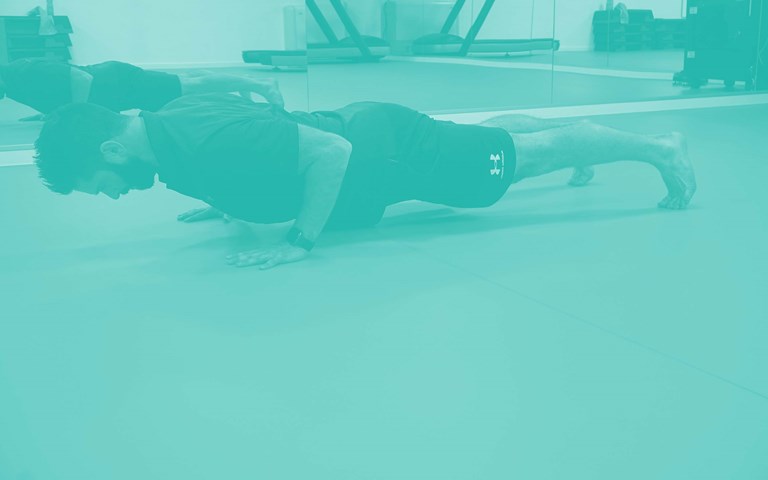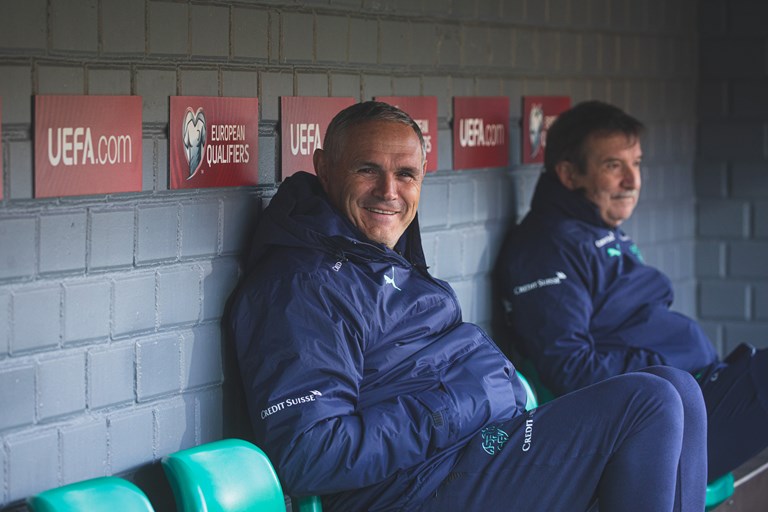
My free body
When we talk about the gym, our imagination may run to futuristic visions of more or less sophisticated equipment. But if we talk about training or functional work, we have to forget about them. All we need is our bodies and the use of small equipment: dumbbells, elastic bands, Swiss balls and so on. No gears, no electronics.

The aim is ‘only’ to develop our motor skills globally, through what are called primitive postural patterns, i.e. the gestures that man has perfected in his evolution to be able to cope with basic needs. Since the dawn of time, moving has been necessary to survive, to find food, to escape from enemies, to go further.
We could say that there is no real human life without movement, so reclaiming movement means reclaiming your life. It is not just a question of figure, muscles or performance. It’s about restoring a psycho-physical balance undermined by hours at your desk or on the sofa.
You don’t need a gym worthy of NASA to do this, you just need a small space in your home and some perseverance. However, it is important to have professionals who understand and correct our mistakes. They can explain and monitor us as we regain our primitive postural patterns. The figure of the personal trainer fits into this context, and we talked about it with Simone Ferrero.
Ferrero, you are a personal trainer, what are the main problems you see in people who are starting to work out?
“Today, many people do desk work, they spend many hours sitting at the computer. This puts a lot of stress on the lower back. It may seem counterintuitive, but it is easier to develop a lumbar hernia by sitting than by working out in the gym. Sitting removes resistance from the back. The natural curvature they have when we stand is lessened. Sitting also affects the cervical area, you stretch your neck and this curvature of the spine is also cancelled out.”
What can be done to remedy these problems?
“We need exercises to strengthen the lower back and abdominal area, for example. But also stretching to lengthen the spine.”
What about the legs?
“Prolonged periods of sitting can lead to water retention, to swelling of the legs. Women are more prone to this. My advice is to drink a lot but not to keep your water bottle on your desk. It’s better to leave it a few metres away, so that you can force yourself to get up, stretch and move.”
Does functional work also improve intellectual performance?
“Not directly, but when people come to the gym they generally do it to switch off, to blow off steam. I notice that if you ask them to do more complex exercises, they say they don’t want to concentrate too much. This means that not only the body has been stressed during the day with the sitting posture, but also the cognitive aspect. Functional work allows you to recreate a balance between movement and thought.”
Is it suitable for everyone?
“Yes. There are no gender or age restrictions. It’s simply a matter of tailoring the exercises to each person’s condition and ability, but it’s a type of exercise that anyone can do.”
When do you feel the benefits?
“Normally, between 24 and 72 hours after the activity, you may experience some fatigue, but after 4-5 training sessions you can already notice improvements. The body rediscovers its primitive movements, we regain possession of them, and minor pains disappear.”
An example of an exercise?
“Let’s take the plank. It involves leaning on your elbows and extending your body by resting your feet as if to form a straight line from your head to your heels. On the surface it may seem like a simple exercise. But if done correctly for a minute, involving all the muscles, it can bring great benefits. If you are just starting out, it is advisable to place your elbows not on the ground but on a box 60 centimetres high, then move down to 45 centimetres and so on. At the beginning you can also bring your knees into support. Then you can do the exercise as described at the beginning.”
Are these just anaerobic exercises?
“No. They are interspersed with activities, such as mini-circuits, that lead to an increase in heart rate causing higher peaks.”
Apart from the gym, what sports do you do?
“Obviously it depends on your own passions. I used to play football in the past and still do when I can, and then I play a game of five-a-side football, ski and ski mountaineering, running, spinning. I like to feel the fatigue.”
What about when you don’t go to the gym? Any advice on how to sit?
“Compared to a chair, it’s better to have a swiss ball, or those ergonomic seats without a backrest and with the knees forward, which keep the back with the correct curves.”
Last question. Is it true that people go to the gym to lose weight?
“I think that’s what 70% of them go for, and 10% to develop their muscles. But I can say that everyone goes there to feel better about their bodies.
Often concentrated in intellectual activities, to which we are called by our professions, transformed into seeing, speaking and typing, sometimes digesting beings, we forget where we started from. Millions of years ago. From getting up on the savannah, from looking over the tall grass, from setting out on the road, from movement.”
Simone Ferrero
Year of birth: 1987
Profession: personal trainer
Born in Biella, Piedmont, after graduating in Motor Sciences from the University of Pavia, he dedicated himself to the activity of personal trainer and specialised by attending the Functional Training School. A Courses instructor, he has been working in Italian Switzerland for 5 years, dividing his time between Villa Sassa in Lugano, Ticino, and the Quartiere Birreria gym in Grono, Graubünden, offering mainly personalised lessons.
The four pillars of functional training
1 - Functional kinetic chains
There are two types. The first is open kinetic chains, those where hands and feet can move freely in space. An example is single joint exercises such as when stretching a leg. The second is closed kinetic chains, which are multi-joint exercises that train the overall movement of the body in a better way. For example, the Squat (leg bends).
2 - Mechanical proprioception and motor control
Proprioception is the awareness of one’s position in the surrounding environment. Accessories such as mini-trampolines, fitness balls, obstacles and proprioceptive platforms are very useful for improving the quality of proprioception. Motor control or coordination, on the other hand, can be trained with specific exercises and with continuous training of the technical gesture over time so that the body memorises automatic response patterns to any external stimulus.
3 - Abdominal belt activity
The human body works with a set of interconnected muscles, although many believe that these act in isolation. The fundamental muscles are those that comprise the torso area or ‘core’: the pelvic floor muscles, the abdominal wall, the column erectors, the multifidus, the hip abductor group, the hip adductor group, the gluteus maximus, the lumbar fascia and the diaphragm. Motor gestures of all kinds always start in the centre of the body, moving towards the periphery. Once the centre of the body is stable, the limbs will have greater mobility and strength, which means greater efficiency and therefore better performance. Core training with the help of equipment such as the bosu (half ball) and Swiss ball (ball).
4 - Similarity or equality to natural movement structure
You do not train individual muscles, but improve and strengthen the movement. Exercises of this kind must therefore be, for example:
• Polyarticular exercises: because they involve several joints, more muscle groups are used in the movement.
• Polyaxial exercises: i.e. motor gestures that also include rotations, twists and translations of the torso to create greater instability.
• Exercises performed in dynamic conditions.
• Exercises with control of posture, stability and proprioception.

Playlist


